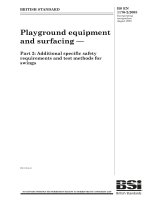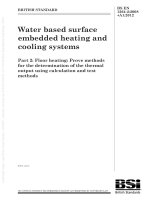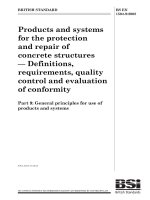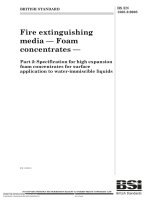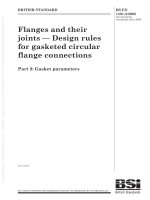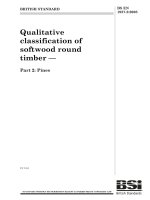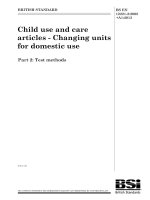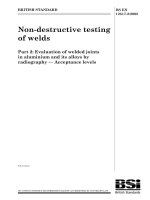Bsi bs en 00508 2 2008 (2009)
Bạn đang xem bản rút gọn của tài liệu. Xem và tải ngay bản đầy đủ của tài liệu tại đây (1.53 MB, 40 trang )
BRITISH STANDARD
Roofing products
from metal sheet —
Specification for self
supporting products
of steel, aluminium or
stainless steel sheet
Part 2: Aluminium
ICS 91.060.20
NO COPYING WITHOUT BSI PERMISSION EXCEPT AS PERMITTED BY COPYRIGHT LAW
BS EN 508-2:2008
Incorporating
Corrigendum
May 2009
BS EN 508-2:2008
National foreword
This British Standard is the UK implementation of EN 508-2:2008. It
supersedes BS EN 508-2:2000 which is withdrawn.
The UK participation in its preparation was entrusted to Technical
Committee B/542/5, Sheet roof and wall coverings.
A list of organizations represented on this committee can be obtained on
request to its secretary.
This publication does not purport to include all the necessary provisions
of a contract. Users are responsible for its correct application.
Compliance with a British Standard cannot confer immunity
from legal obligations.
This British Standard
was published under the
authority of the Standards
Policy and Strategy
Committee on 31 March
2009
© BSI 2009
ISBN 978 0 580 67409 9
Amendments/corrigenda issued since publication
Date
Comments
31 May 2009
Replacement of CEN ratified text
BS EN 508-2:2008
EUROPEAN STANDARD
EN 508-2
NORME EUROPÉENNE
EUROPÄISCHE NORM
July 2008
ICS 91.060.20
Supersedes EN 508-2:2000
English Version
Roofing products from metal sheet - Specification for selfsupporting products of steel, aluminium or stainless steel sheet Part 2: Aluminium
Produits de couverture en tôle métallique - Spécification
pour les plaques de couverture en tôle d'acier, d'aluminium
ou d'acier inoxydable - Partie 2 : Aluminium
Dachdeckungsprodukte aus Metallblech - Spezifikation für
selbsttragende Bedachungselemente aus Stahlblech,
Aluminiumblech oder nichtrostendem Stahlblech - Teil 2:
Aluminium
This European Standard was approved by CEN on 30 May 2008.
CEN members are bound to comply with the CEN/CENELEC Internal Regulations which stipulate the conditions for giving this European
Standard the status of a national standard without any alteration. Up-to-date lists and bibliographical references concerning such national
standards may be obtained on application to the CEN Management Centre or to any CEN member.
This European Standard exists in three official versions (English, French, German). A version in any other language made by translation
under the responsibility of a CEN member into its own language and notified to the CEN Management Centre has the same status as the
official versions.
CEN members are the national standards bodies of Austria, Belgium, Bulgaria, Cyprus, Czech Republic, Denmark, Estonia, Finland,
France, Germany, Greece, Hungary, Iceland, Ireland, Italy, Latvia, Lithuania, Luxembourg, Malta, Netherlands, Norway, Poland, Portugal,
Romania, Slovakia, Slovenia, Spain, Sweden, Switzerland and United Kingdom.
EUROPEAN COMMITTEE FOR STANDARDIZATION
COMITÉ EUROPÉEN DE NORMALISATION
EUROPÄISCHES KOMITEE FÜR NORMUNG
Management Centre: rue de Stassart, 36
© 2008 CEN
All rights of exploitation in any form and by any means reserved
worldwide for CEN national Members.
B-1050 Brussels
Ref. No. EN 508-2:2008: E
BS EN 508-2:2008
EN 508-2:2008 (E)
Contents
Page
Foreword..............................................................................................................................................................4
Introduction .........................................................................................................................................................5
1
Scope ......................................................................................................................................................6
2
Normative references ............................................................................................................................6
3
3.1
3.2
3.3
3.4
3.5
Terms and definitions, symbols and abbreviations...........................................................................6
General....................................................................................................................................................6
Material definitions ................................................................................................................................6
Profile definitions...................................................................................................................................7
Product geometry ..................................................................................................................................9
Symbols and abbreviations ................................................................................................................12
4
4.1
4.2
4.2.1
4.2.2
4.3
4.3.1
4.3.2
4.3.3.
4.3.4
4.3.5
Requirements .......................................................................................................................................13
General..................................................................................................................................................13
Materials ...............................................................................................................................................13
Aluminium ............................................................................................................................................13
Organic coatings..................................................................................................................................14
Products ...............................................................................................................................................15
Mechanical resistance.........................................................................................................................15
Calculation and tests of mechanical resistance...............................................................................15
Dimensions...........................................................................................................................................15
Dimensional tolerances for the profiled sheet .................................................................................16
Safety in case of fire ............................................................................................................................16
5
5.1
5.2
5.3
Test methods........................................................................................................................................16
Material properties...............................................................................................................................16
Surface properties ...............................................................................................................................16
Structural properties ...........................................................................................................................16
6
Designation ..........................................................................................................................................16
7
7.1
7.2
7.3
Marking, labelling and packaging ......................................................................................................17
Marking and labelling ..........................................................................................................................17
Packaging and special ordering conditions .....................................................................................17
Transport, storage and handling........................................................................................................17
Annex A (normative) Dimensional tolerances ..............................................................................................18
A.1
Tolerances for trapezoidal sheets......................................................................................................18
A.1.1 General..................................................................................................................................................18
A.1.2 Depth of profile ....................................................................................................................................18
A.1.3 Depth of stiffeners ...............................................................................................................................19
A.1.4 Pitch ......................................................................................................................................................19
A.1.5 Widths of crown and valley ................................................................................................................20
A.1.6 Cover width ..........................................................................................................................................20
A.1.7 Radius of bends ...................................................................................................................................21
A.1.8 Deviation from straightness ...............................................................................................................22
A.1.9 Deviation from squareness.................................................................................................................23
A.1.10 Length ...................................................................................................................................................23
A.1.11 Deviation of side lap ............................................................................................................................24
A.1.12 Curve radius and angles .....................................................................................................................24
A.2
Tolerances for sinusoidal profiles .....................................................................................................25
A.3
Tolerances on tiles ..............................................................................................................................25
A.3.1 General..................................................................................................................................................25
A.3.2 Depth of tile ..........................................................................................................................................26
A.3.3 Web angular displacement (Figure A.12) ..........................................................................................27
2
BS EN 508-2:2008
EN 508-2:2008 (E)
A.3.4
A.3.5
A.3.6
A.3.7
A.3.8
A.3.9
A.3.10
A.3.11
A.4
A.4.1
A.4.2
A.4.3
A.4.4
A.4.5
A.4.6
A.4.7
A.4.8
A.4.9
A.4.10
A.4.11
A.4.12
Pitch ......................................................................................................................................................27
Width of crown and valley (Figure A.14) ...........................................................................................27
Cover width ..........................................................................................................................................28
Radius of bends...................................................................................................................................28
Deviation from straightness ...............................................................................................................29
Deviation from squareness ................................................................................................................29
Length...................................................................................................................................................30
Contraction or bulging........................................................................................................................30
Methods for measuring profiles.........................................................................................................31
General .................................................................................................................................................31
Depth of profile ....................................................................................................................................31
Depth of stiffeners...............................................................................................................................31
Pitch ......................................................................................................................................................31
Width of crown and valley ..................................................................................................................32
Cover width ..........................................................................................................................................33
Radius of bends...................................................................................................................................33
Straightness .........................................................................................................................................33
Squareness ..........................................................................................................................................33
Length...................................................................................................................................................33
Side laps ...............................................................................................................................................33
Side lap ripple ......................................................................................................................................33
Annex B (informative) Test methods for concentrated load ........................................................................35
Bibliography......................................................................................................................................................36
3
BS EN 508-2:2008
EN 508-2:2008 (E)
Foreword
This document (EN 508-2:2008) has been prepared by Technical Committee CEN/TC 128 “Roof covering for
discontinuous laying and products for wall cladding”, the secretariat of which is held by NBN.
This European Standard shall be given the status of a national standard, either by publication of an identical
text or by endorsement, at the latest by January 2009, and conflicting national standards shall be withdrawn at
the latest by January 2009.
Attention is drawn to the possibility that some of the elements of this document may be the subject of patent
rights. CEN [and/or CENELEC] shall not be held responsible for identifying any or all such patent rights.
This document supersedes EN 508-2:2000.
EN 508 Roofing products from metal sheet - Specification for self-supporting products of steel, aluminium or
stainless steel sheet consists of the following parts:
Part 1:
Steel;
Part 2:
Aluminium;
Part 3: Stainless steel.
According to the CEN/CENELEC Internal Regulations, the national standards organizations of the following
countries are bound to implement this European Standard: Austria, Belgium, Bulgaria, Cyprus, Czech
Republic, Denmark, Estonia, Finland, France, Germany, Greece, Hungary, Iceland, Ireland, Italy, Latvia,
Lithuania, Luxembourg, Malta, Netherlands, Norway, Poland, Portugal, Romania, Slovakia, Slovenia, Spain,
Sweden, Switzerland and the United Kingdom.
4
BS EN 508-2:2008
EN 508-2:2008 (E)
Introduction
Figure 1 indicates the position of this standard in the CEN framework of standards concerning roofing
products of metal.
Roofing products of
metal
Self-supporting products
Fully supported products
EN 14782
Copper /
Zinc
EN 506
Steel
EN 508-1
Aluminium
EN 508-2
Stainless steel
EN 508-3
Figure 1 — Framework of standards
In this standard the performance of the product has been defined in terms of calculation and a number of type
tests.
The performance of a roof constructed with these products depends not only on the properties of the product
as required by this standard, but also on the design, construction and performance of the roof as a whole in
relation to the environment and conditions of use.
5
BS EN 508-2:2008
EN 508-2:2008 (E)
1
Scope
This part of EN 508 specifies requirements for self-supporting roofing products for discontinuous laying made
from aluminium sheet with or without additional organic coatings.
The standard establishes general characteristics, definitions, classifications and labelling for the products,
together with requirements for the materials from which the products can be manufactured. It is intended to be
used either by manufacturers to ensure that their products comply with the requirements or by purchasers to
verify that the products comply before they are despatched from the factory. It specifies the requirements for
products which enable them to meet all normal service conditions.
The standard applies to all discontinuously laid self-supporting external profiled sheets for roofing. These
profiled roof sheets are designed to keep wind, rain and snow out of the building, and to transfer any resultant
loads and infrequent maintenance loads to the structure.
No requirements for supporting construction, design of roof system and execution of connections and
flashings are included.
2
Normative references
The following referenced documents are indispensable for the application of this document. For dated
references, only the edition cited applies. For undated references, the latest edition of the referenced
document (including any amendments) applies.
EN 485-4, Aluminium and aluminium alloys - Sheet, strip and plate - Part 4: Tolerances on shape and
dimensions for cold-rolled products.
EN 1396, Aluminium and aluminium alloys - Coil-coated sheet and strip for general applications –
Specifications.
3
Terms and definitions, symbols and abbreviations
For the purposes of this document, the following terms and definitions apply.
3.1
General
3.1.1
self-supporting product
Product which will, by virtue of its material and shape, support all applied loadings (e.g. snow, wind, foot
traffic), and transmit these loadings to spaced structural supports
3.2
Material definitions
3.2.1
aluminium
unalloyed aluminium or aluminium
3.2.2
unalloyed aluminium
metal with a minimum content of 99,0% by mass of aluminium and with content by mass of any other element
within the following limits :
6
a total content of iron and silicon not greater than 1,0% ;
BS EN 508-2:2008
EN 508-2:2008 (E)
a content of any other element not greater than 0,10% except for copper which can have a content of up
to 0,20% provided that neither the chromium nor the manganese content exceeds 0,05%.
3.2.3
aluminium alloy
alloy in which aluminium predominates by mass overreach of the other elements and which is not covered by
the definition of unalloyed aluminium
3.2.4
temper
material conditions after a production stage, for example mechanical treatment and/or heat treatment,
intended to give the material physical and/or metallurgical properties
3.2.5
organic coated aluminium sheet
painted, post coated, laminated or coil coated (continuously organic coated) aluminium on one or on both
sides
3.3
Profile definitions
3.3.1
trapezoidal profiled sheet
self-supporting sheet which is designed to allow it to be side and end lapped, the crowns of which may be
rounded and, in addition, the crowns, web and valley may be stiffened
NOTE
See Figures 2, 3, 4 and 5.
Figure 2 — Part of typical trapezoidal profile
Figure 3 — Part of typical trapezoidal profile with rounded crowns
Figure 4 — Part of typical trapezoidal profile with stiffened crown and web
7
BS EN 508-2:2008
EN 508-2:2008 (E)
Figure 5 — Part of typical trapezoidal profile with stiffened valley
3.3.2
sinusoidal profiled sheet
self-supporting sheet which is designed to allow it to be side and end lapped, comprising a series of arc
shaped crowns and valleys interconnected with tangential webs
NOTE
See Figure 6.
Figure 6 — Part of typical sinusoidal profiled sheet.
3.3.3
standing seam and concealed fix sheet
self-supporting sheet profiled in such a way that the fixings are hidden within the construction and are not
exposed to the weather
NOTE 1
See Figures 7 and 8.
NOTE 2
The profile shape is designed to allow the formation of side laps on site.
NOTE 3
As these types of roof covering products are used in proprietary roofing systems, no structural requirements
are given within this standard.
NOTE 4
These products are normally designed by testing.
Figure 7 — Typical standing seam profile
8
BS EN 508-2:2008
EN 508-2:2008 (E)
Figure 8 — Typical concealed fix profile
3.3.4
tile profiles
parts of typical tile profiled sheets that can allow the sheet to be side and/or end lapped
NOTE 1
See figures 9a, 9b and 9c.
NOTE 2
The tile profiles may include transverse steps.
NOTE 3
As these types of roof covering products are used in proprietary systems no structural requirements are given
within this part of EN 508.
NOTE 4
These products are normally designed by testing.
Figure 9 — Typical tile profiles
3.4
Product geometry
NOTE
The names for various parts of typical trapezoidal profiled sheets are given in Figures 10a and 10b, with
additional definitions for sinusoidal profiles in Figure 11 and tile profiles in Figure 12.
9
BS EN 508-2:2008
EN 508-2:2008 (E)
Key
1
Cover width
7
Depth
2
3
Valley stiffener
Rib
8
9
Valley
Pitch
4
5
Web stiffener
Trough
10 Crown
11 Drainage groove
6
Web
12 Crown stiffener
a) Definitions of the parts of typical trapezoidal profiled sheets
10
BS EN 508-2:2008
EN 508-2:2008 (E)
Key
1
2
Bend radius
End lap
3
4
Web angle
Overlap
5
6
Underlap
Side lap in principle the same on tiles
b) Definitions of the parts of typical trapezoidal profiled sheets
Figure 10: Definitions of the parts of typical profiled sheets
11
BS EN 508-2:2008
EN 508-2:2008 (E)
Key
1
Depth
2
Pitch
Figure 10 — Definitions of the parts of typical sinusoidal profiled sheets
Key
1
2
Height of the step
Length of the step
3
4
Number of steps
End lap
Figure 11 — Definitions of the parts of typical tile
3.5
Symbols and abbreviations
AA
The symbols for aluminium sheets are the alloy symbols as in 4.2.1
H
Aluminium temper symbol
AY
Acrylic paint coating
SP
Polyester paint coating
SP-SI
Silicone-modified polyester paint coating
12
BS EN 508-2:2008
EN 508-2:2008 (E)
PVDF
Polyvinylidenefluoride paint coating
PVF(F)
Polyvinylfluoride film coating
SP-PA
Polyamid-modified polyester paint coating
PUR
Polyurethane paint coating
PUR-PA
Polyamide-modified polyurethane paint coating
AK
Alkyd paint coating
EP
Epoxy paint coating for use within a building
4
Requirements
4.1
General
The product shall be manufactured from materials complying with clause 4.2.
NOTE 1
The supplier of the materials is responsible for carrying out the tests necessary to verify that the materials
supplied to the manufacturer comply with the requirements and should provide appropriate inspection documents
(according to EN 10204) on request.
NOTE 2
The symbols and abbreviations to be used to designate the aluminium alloy, the type and thickness of the
organic coating are those of the standards referred to in clause 2.
Product testing shall be provided to a defined schedule and carried out by the manufacturer or by an approved
body. A permanent quality system shall be adopted by the manufacturer1).
4.2
4.2.1
Materials
Aluminium
Aluminium alloys given in Table 1 are suitable provided that their properties conform to the values given in the
relevant material standards (e.g. EN 485-2, EN 573-3).
1).E.g. quality management system based on EN ISO 9001.
13
BS EN 508-2:2008
EN 508-2:2008 (E)
Table 1 — Alloys of aluminium
Designation based on chemical
symbol
Numerical designation
EN AW-3003
EN AW-Al Mn1Cu
EN AW-3004
EN AW-Al Mn1Mg1
EN AW-3005
EN AW-Al Mn1Mg0,5
EN AW-3103
EN AW-Al Mn1
EN AW-3105
EN AW-Al Mn0,5Mg0,5
EN AW-4015
EN AW-Al Si2Mn
EN AW-4016
EN AW-Al Si2MnZn
EN AW-4017
EN AW-Al Si1MnCu
EN AW-5005
EN AW-Al Mg1(B)
EN AW-5052
EN AW-Al Mg2,5
EN AW-5251
EN AW-Al Mg2
EN AW-5754
EN AW-Al Mg3
EN AW-8011 A
EN AW-Al Fe Si (A) a
a
Only with organic coatings on both surfaces.
Temper shall be chosen so that the ultimate tensile strength is not lower than 150 MPa.
NOTE
Alloy and temper are chosen to give corrosion resistance, strength and formability. Specification of alloy,
temper and coating finish should be agreed between purchaser and supplier at the time of ordering.
Tolerances on shape and dimensions shall be in accordance with EN 485-4.
4.2.2
Organic coatings
The main external weather resistant organic coatings suitable for application to aluminium substrates are
given in Table 2.
Table 2 — Factory applied organic coatings
Type of coating
Factory applied coatings
Factory applied laminated film
NOTE 1
14
Designation
Acrylic
AY
Polyester
SP
Silicone-modified polyester
SP-SI
Polyvinylidene fluoride
PVDF
Polyamide-modified polyurethane
PUR-PA
Polyurethane
PUR
Polyamide-modified polyester
SP-PA
Alkyd
AK
Epoxy
EP
Polyvinyl fluoride
PVF(F)
Remarks
With proper primers
Only within buildings
Aluminium sheet is used either without coating or with organic coatings mainly for aesthetic reasons.
BS EN 508-2:2008
EN 508-2:2008 (E)
NOTE 2
It should be noted that different coating systems behave in different ways under various climatic conditions.
The primer and/or adhesive should be chosen taking into account which type of substrate, pretreatment and top coat are
used.
Reverse side painting or coating is used if being required for handling and storage reasons as well as for
corrosion protection in some installation conditions.
Performance and test methods for coil coated aluminium shall be in accordance with EN 1396.
NOTE 3
Special coatings or films may be applied to the reverse side to reduce the dripping of moisture caused by
condensation.
4.3
Products
4.3.1
Mechanical resistance
The product shall resist the design loads from snow, wind and maintenance. These loads shall be factored
such that they will not impair the performance of the roof.
NOTE
4.3.2
The load level, the levels of safety and permissible deflection are defined in national building regulations.
Calculation and tests of mechanical resistance
The mechanical performance of the product shall be stated by the manufacturer, together with details of how
the values were determined in accordance with the national regulations of the country where the product is to
be used.
NOTE 1
For calculation and testing either national regulations or EN 1999-1-4 may be used.
NOTE 2
Calculation and test methods referred to in this EN mainly deal with trapezoidal sheets. Tiles, standing seam
sheets and concealed fix sheets are used in proprietary roofing systems, no structural requirements are given within this
standard for these products. These products should normally be designed by testing.
4.3.3. Dimensions
4.3.3.1
General
The dimensions of the product shall be fixed in order that the roof constructed with these products can fulfil its
functions.
4.3.3.2
Thickness
Measurements of the thickness of manufactured products such as profiled sheets shall be made not less than
10 mm from the edges in accordance with EN 485-4.
Products shall be classified according to tolerance on thickness as follows:
class 1: full minus nominal normal tolerance according to EN 485-4;
class 2: 1/2 minus nominal normal tolerance according to EN 485-4;
class 3: zero minus tolerance.
NOTE 1
For products of class 3, mechanical resistance is calculated using the minimum thickness of the aluminium
core guaranteed by the manufacturer.
NOTE 2
National regulations will state the class of product that it will be possible to use.
15
BS EN 508-2:2008
EN 508-2:2008 (E)
4.3.4
Dimensional tolerances for the profiled sheet
Tolerances for the profile shape of the product and methods of measurement shall be in accordance with
Annex B.
4.3.5
Safety in case of fire
Until the withdrawal of national technical specifications, products coated with organic coatings shall comply
with these specifications.
NOTE 1
The withdrawal of national technical specifications will occur in the European Union at the end of the
transitional period of EN 14782.
NOTE 2
Aluminium is non-combustible. It will not burn and will not support combustion. Its melting point is
approximately 630 °C, so it will melt in an intense fire. It is essential that the effect of a fire is evaluated after studying the
whole structure.
5
5.1
Test methods
Material properties
Test methods for material properties are given in the appropriate material standards as detailed in 4.2.
5.2
Surface properties
Test methods for surface properties are given in EN 1396.
5.3
Structural properties
The performance of the product under distributed load shall be determined in accordance with 4.3.1 and 4.3.2.
The performance of the product under concentrated load shall be quoted by the manufacturer with reference
to the method used to determine the results.
NOTE
Safety under the load from people and the risk of permanent deformation is dependent on many factors, such
as slope of roof, method of installation, etc.
Methods for testing the strength under concentrated load are not yet available on a European level. Information on
national standards is given in Annex C. Rules for installation are given in some national codes.
6
Designation
Products covered by this part of EN 508 shall be designated as follows:
type of product according to the designation of the manufacturer;
European standard number;
nominal thickness and thickness class (see 4.3.3.2);
material (designation of material) (see 3.5 and 4.2);
length;
length of step (only for tiles).
16
BS EN 508-2:2008
EN 508-2:2008 (E)
EXAMPLE
Profile 45, thickness 0,7 mm, class 1;
length 4200 mm; EN AW-3103, H18
Side 1: PVDF 25 µm colour RAL 24
Side 2: AY 25 µm colour RAL 10
EN 508-2
7
7.1
Marking, labelling and packaging
Marking and labelling
At least the following information shall be attached to every pack, bundle or delivery unit:
name or registered identification of the manufacturer;
product designation (see clause 6);
order or manufacturing batch number;
dimension and quantity;
gross mass (kg).
7.2
Packaging and special ordering conditions
The packaging requirements and any special requirements to take account of particular conditions shall be
agreed between manufacturer and purchaser at the time of ordering.
7.3
Transport, storage and handling
Any instructions regarding transport, storage and handling shall be clearly visible on the package.
NOTE 1
The packages should be supported by means of battens providing sufficient space to permit good ventilation
while avoiding any permanent deformation of the sheets. The packages should be inclined in order to promote drainage.
The package should be stored under a covered warehouse or under a cover made from tarpaulin over a frame. The frame
should allow sufficient space between tarpaulin and packages to allow air to circulate.
NOTE 2
Moisture, in particular condensation inside packages, can lead to the formation of stains (e.g. black marks),
and if there is prolonged contact with moisture, can cause aesthetic change.
During transportation, dark spots can appear on light surfaces as a result of friction in contact with uncoated aluminium
when packing allows movement between neighbouring surfaces.
NOTE 3
If severe service conditions are expected during transportation, storage or processing, the product can be
supplied with an additional protection of a temporary, strippable film, wax or oil.
Type, thickness, adhesion properties, formability, tear strength and light fastness should be taken into consideration when
choosing protective films. All protective films can be exposed to outdoor weathering for only a limited period without
deterioration.
17
BS EN 508-2:2008
EN 508-2:2008 (E)
Annex A
(normative)
Dimensional tolerances
A.1 Tolerances for trapezoidal sheets
A.1.1 General
The following tolerances shall apply to measurements in the factory, before delivery and shall be corrected for
temperature variations to 20 °C where appropriate.
The tolerances are maxima, a roofing system may require smaller tolerances for the sheets to fit together to
form a functional roof on one building.
Methods suitable for the measurement of the values are given in Clause A.4.
The following values are defined with tolerances:
A.1.2
Depth of profile (h)
A.1.3
Depth of stiffeners
A.1.4
Pitch
A.1.5
Width of crown and valley (b1, b2)
A.1.6
Cover width (w)
A.1.7
Radius of bends (r)
A.1.8
Deviation from straightness (δ)
A.1.9
Deviation from squareness (s)
A.1.10
Length (l)
A.1.11
Deviation of side lap (D)
A.1.12
Curve radii and angles
A.1.2 Depth of profile
The depth of the profile (h) shall be measured as the distance between the crown and valley measured on the
same side of the sheet (see Figure A.1), at 200 mm from the sheet end.
18
BS EN 508-2:2008
EN 508-2:2008 (E)
Depth of profile
Tolerance
h ≤ 50 mm
± 1 mm
50 mm < h ≤ 100 mm
± 1,5 mm
h >100 mm
± 2 mm
Figure A.1 — Depth of profile
A.1.3 Depth of stiffeners
The depth of any stiffeners, on crown, valley or web shall be measured on a line across the sheet at 200 mm
from the end.
Tolerances: ± 1 mm
A.1.4 Pitch
The pitch of the profile (see Figure A.2) shall be the distance between the centre of adjacent ribs, measured at
200 mm from sheet ends.
Depth of profile
Tolerance
h ≤ 50 mm
± 2 mm
50 mm < h ≤ 100 mm
± 3 mm
h >100 mm
± 4 mm
Key
1
Pitch
Figure A.2 — Pitch
19
BS EN 508-2:2008
EN 508-2:2008 (E)
A.1.5 Widths of crown and valley
The widths of a crown (b1) and valley (b2) (see Figure A.3) shall be measured at 200 mm from the sheet ends.
2
Tolerances: +
− 1 mm
Figure A.3 — Widths of crown and valley
A.1.6 Cover width
The cover width, w, shall be stated by the manufacturer.
Measurements of cover width w1 and w2 shall be taken at a distance of 200 mm from the sheet ends as shown
in Figure A.4. Both measurements shall be within the specified tolerance selected for the appropriate sheet
profile depth (h).
A third measurement w3 of cover width shall be made across the centre line of the sheet to determine the
contraction or bulging of the profile. This w3 measurement shall be within the stated tolerance referred to the
average value for w1 and w2 (i.e.
20
w1 + w2
).
2
BS EN 508-2:2008
EN 508-2:2008 (E)
Depth of profile Tolerance
h ≤ 50 mm
± 5 mm
h > 50 mm
±
NOTE
h
, maximum 15 mm.
10
h is the nominal profile depth (see A.1.2).
Key
1
2
Centre line of sheet
Cover width (w)
Figure A.4 — Cover width
A.1.7 Radius of bends
The measurement shall be carried out on the inside radii at a distance of at 200 mm from one end of the sheet
as shown in Figure A.5.
Tolerances: +2,0
0 mm
21
BS EN 508-2:2008
EN 508-2:2008 (E)
Key
r
Inside radius
Figure A.5 — Radius of bends
A.1.8 Deviation from straightness
The deviation of straightness from the theoretical straight line shall be defined as the dimension δ in Figure A.6.
Tolerance: 2,0 mm/m of sheet length, not exceeding 10 mm.
Key
1
Centre line of sheet
2
Straight line laid along edge of crown
δ
Displacement of edge of crown from straight line
Figure A.6 — Deviation of straightness
22
BS EN 508-2:2008
EN 508-2:2008 (E)
A.1.9 Deviation from squareness
The deviation from squareness of the profiled sheet end shall be defined as the dimension S in Figure A.7.
Tolerance: S ≤ 0,5% of the nominal cover width (w).
NOTE
The nominal cover width (w) is specified in A.1.6.
Figure A.7 — Squareness
A.1.10 Length
The length (l) shall be measured along the centre axis of the sheet as shown in Figure A.8.
Length
Tolerance
l ≤ 3000 mm
l > 3000 mm
NOTE
+10
mm
−5
+ 20
mm
−5
Specific requirements may be agreed upon by the manufacturer and the purchaser at the time of ordering.
23

